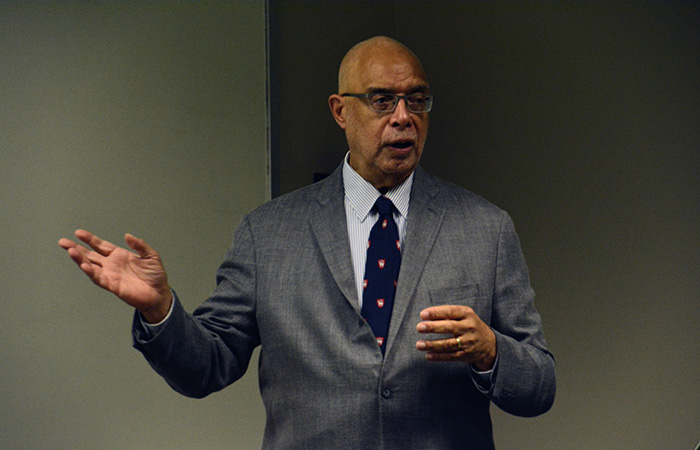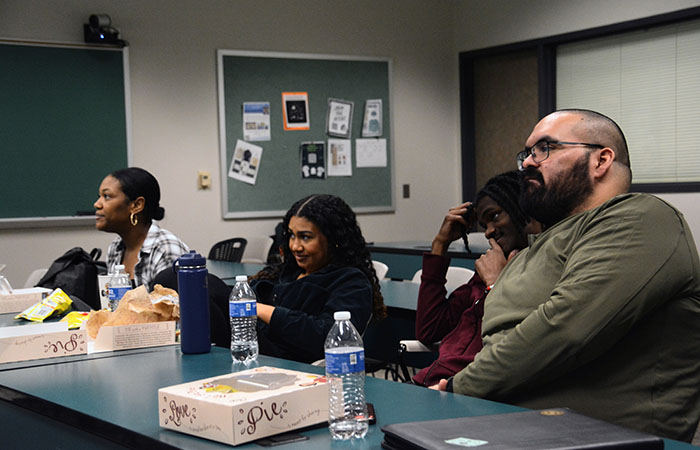MSU Law Professor Probes Use of Racial and Ethnic Imagery
In the second of his two lectures on “Image and Identity,” MSU Law Visiting Professor Myles Lynk delved deeper into the ongoing use of imagery of minority cultures in commercial branding and advertising in his presentation entitled, “Commercial Speech in a Diverse Society: The Ethics, Law and History of Racial and Ethnic Imagery in Sports and Advertising,” He closely examined the appropriation of Native American culture in American sports at the professional, collegiate and high school levels, and the uses of other racial and ethnic images and stereotypes in commercial advertising throughout the 20th century.

Professor Lynk
With respect to the historically pernicious use of Native American images in sports mascots and logos, Professor Lynk noted, “I argue that teams using Native American imagery set out to associate the team with certain positive qualities of the depicted group,” while the use of other racial images and stereotypes in advertising is often intended to “poke fun at [the depicted group] with humorous contempt.” He asked the audience to consider, “What is more important: Intent or Effect? If the use of an image has the ‘effect’ of causing offense to members of the group being depicted, should the person or entity using the image stop using it, even if there was no ‘intent’ to offend?”
It’s this question of intent vs. effect that Professor Lynk encourages the next generation of lawyers and lawmakers to consider, as issues like this become more hot button. Professor Lynk has been immersed in this topic since serving as NCAA Faculty Athletics Representative at Arizona State University in the early 2000s. His familiarity with the negative impact that offensive images have had on marginalized communities coincided with the NCAA’s adoption of a policy officially prohibiting any display of Native American imagery during NCAA championships, except in situations where consent is given by the depicted group.
Engaging further with the audience, Professor Lynk posed the question of why Native Americans have a considerable history of protesting their misrepresentation in athletics, while other groups – such as Irish Americans or Americans of Scandinavian descent – appear not to mind. Why isn’t there an uproar by members of these groups? Some members even embrace these representations, such as the Fighting Irish mascots for the University of Notre Dame and the Minnesota Vikings professional football team. Professor Lynk says he’s not surprised by the broad acceptance of this imagery.
For example, “as Irish Americans became more established and powerful in this country, the reference to their hard-scrabble past became a badge of pride,” said Professor Lynk. “It allows them to look back and say, ‘Look where we came from, and look where we are now.’”
Professor Lynk suggests that much of Native Americans’ displeasure with their depiction in sports does not stem from a desire for political correctness. “The images of Native Americans everywhere serve as reminders to all Americans,” said Professor Lynk of the issue. “We want to remember – and are still trying to make sense of – the strange, complicated and powerful history we share.”
In addition to discussing Native American representation in sports culture due to its high profile, Professor Lynk’s presentation had a broader purpose by comparing these representations with the representations of African American and Hispanic Americans in commercial product advertising. For example, what messages were Aunt Jemima, Uncle Ben, the Coon Chicken Inn, Lazy Peon, the Frito Bandito, and Chiquita Banana, intended to send?
Highlighting the intricacies of the bigger picture issue, Professor Lynk suggested that the use of imagery representing minority populations is an issue involving brand creation across multiple industries. When lawyers are called upon to assist their clients in addressing these issues, they should consider their jurisdiction’s equivalent to Model Rule of Professional Conduct 2.1: “In rendering advice, a lawyer may refer not only to law, but to other considerations such as moral, economic, social and political factors, that may be relevant to the client’s situation.”

MSU Law students

